The Electrical System is often one of the most complicated steps in a DIY van conversion.
How much energy is needed? What apparatus/devices to purchase? How to connect them? How much would it cost?
These are all doubts and questions that normally everyone finds in his way, and which often slow down the conversion process.
In this article you will find simple and complete wiring diagrams to help you speed up the realization of your dream on wheels 🙂
INTRODUCTION:
GROW YOUR KNOWLEDGE ON THE SUBJECT BEFORE YOU START!
Making an electrical system tailored to your needs takes time, study and attention.
First, if you have never worked with electricity, it is important to understand how an electrical system works, what hazards to watch out for, and precautions to take to avoid hurting yourself or otherwise ruining the expensive components you are going to install.
If you are just now beginning to take an interest in the subject and don’t even have any idea where to start getting your hands on it, I suggest you read the following Maxi-guide I have written in which you can understand in detail how each and every component of an RV electrical system works:
Instead, below I leave you another Guide that can help you from a practical point of view just to “get your hands on it.”
If you have already read the previous articles, have been directed here from those pages, or are otherwise not interested in theory but only in finding a simple and concise diagram on how to create the ‘DIY electrical system best suited to your van, well here you are in just the right place!
In fact, below I offer you as many as 4 different Electrical Installations Schemes: from a basic low-cost installation for light use, to an “Ultra” electrical installation suitable for a home on wheels for full-timers.
Each scheme is accompanied by a list of technical specifications, an approximate cost to give you an idea of how much it may come to cost, information regarding the needs it can meet and the equipment it can power.
In addition, for your convenience, clicking on the various components of the systems allows you to view the related components directly on Amazon.
Forget the hundreds of hours searching for information and online consultations, here you will find everything you need to create an electrical system that fits your project!
Let’s get started right away! 🙂
NOTE: Do you want to support LostOnTheRoute? Should you decide to purchase any products through the links in this article, as a participant in the Amazon Affiliate program, I receive a small percentage that I use to support the server costs of this blog, at no extra cost to you 🙂
TABLE OF CONTENTS
4 Van Electrical Diagrams to Create and Wire your System
of Your Do-It-Yourself Camper
1. Electrical System Diagram “Basic AGM”

Click on the various components of the electrical system to see their details or to examine the product page directly.
FACILITY IN BRIEF
The “Basic AGM” electrical system is simple to assemble and consists of inexpensive apparatus that does the job.
It includes three charging modes to grant maximum flexibility, and is ideal for supporting small needs.
To save money, the battery is not lithium, but an AGM, which can then be drained down to 50% of its charge.
TECHNICAL FEATURES
- Battery Bank: 140ah AGM
- Usable Battery: 70ah
- Solar Charging: 200W (expandable up to 300W)
- Alternator Charging: Manual Isolator, 120A max.
- Mains Charging: Up to 12A, 100% charge overnight
- Inverter Power: 300W
- Monitoring: Physical Screen with % Batteries
CHOOSE THIS CONFIGURATION IF:
- You have limited energy consumption and use your vehicle mainly as a “base” for exploring and experiencing the outdoors
- You want a Simple and Affordable Plant
- Are you interested in powering a 12V Fridge for 24h
- Want to power Small Utilities (LED Lights, Water Pump, Fan, Charging PC/Cell Phone, TV) for a few hours a day
APPROXIMATE COST
700 – 800 Euro
The cost estimate is based on Amazon prices and my personal experience and is purely indicative, to give you an idea of how much more or less, you would be going to spend.
The guideline cost includes all the essential components of the system (solar panels, chargers, batteries, inverters, fuses, cables etc.), but not the various DC and AC equipment (since everyone then plugs in what they want, and it would not make sense to put them in the count).
2. Electrical System Diagram “Lithium Starter”
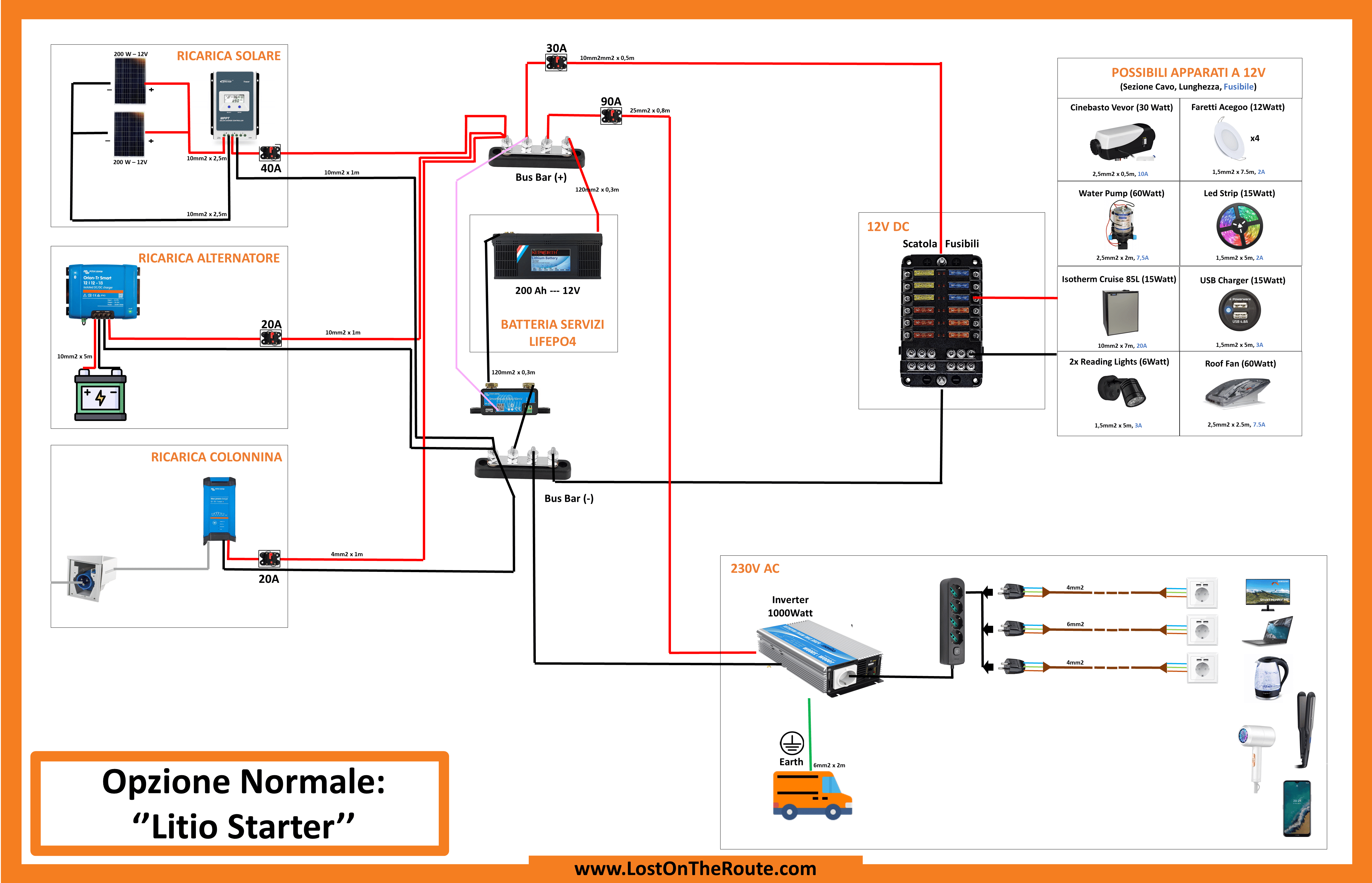
Click on the various components of the electrical system to see their details or to examine the product page directly.
FACILITY IN BRIEF
The “Lithium Starter” electrical system is based on the use of a large 200ah LifePO4 lithium battery, which, thanks to deep cycle technology, can be drained to 80% of its capacity.
This, leaves 160ah usable, more than enough capacity to meet most of an RV’s energy needs (except electric cooking and cooling).
A 1000W inverter converts battery current into 220V current, and allows the use of small hair dryers, straighteners or kettles, or other energy-efficient appliances.
TECHNICAL FEATURES
- Battery Bank: 200ah Lifepo4 Deep Cycle
- Usable Battery: 160ah
- Solar Charging: 400W
- Alternator Charging: Automatic, 18A max.
- Mains Charging: Up to 15A, full charging in one night
- Inverter Power: 1000W
- Monitoring: Monitoring via Bluetooth/ VictronConnect App
CHOOSE THIS CONFIGURATION IF:
- You want to create a lithium system that meets all your needs without having to worry too much about constantly checking the battery
- Do not plan to cook using electricity
- Do you want to power a 24h compressor refrigerator (12V), or use common 220V apparatus (hot plate, low-power hair dryer/boiler, powerful battery charger etc.).
- You want to have the energy independence to spend a few days even free-staying away from the camping pillar and equipped areas
APPROXIMATE COST
2000 – 2300 Euro
The cost estimate is based on Amazon prices and my personal experience and is purely indicative, to give you an idea of how much more or less, you would be going to spend.
The guideline cost includes all the essential components of the system (solar panels, chargers, batteries, inverters, fuses, cables etc.), but not the various DC and AC equipment (since everyone then plugs in what they want, and it would not make sense to put them in the count).
3. “Advanced Lithium” Electrical System Diagram.
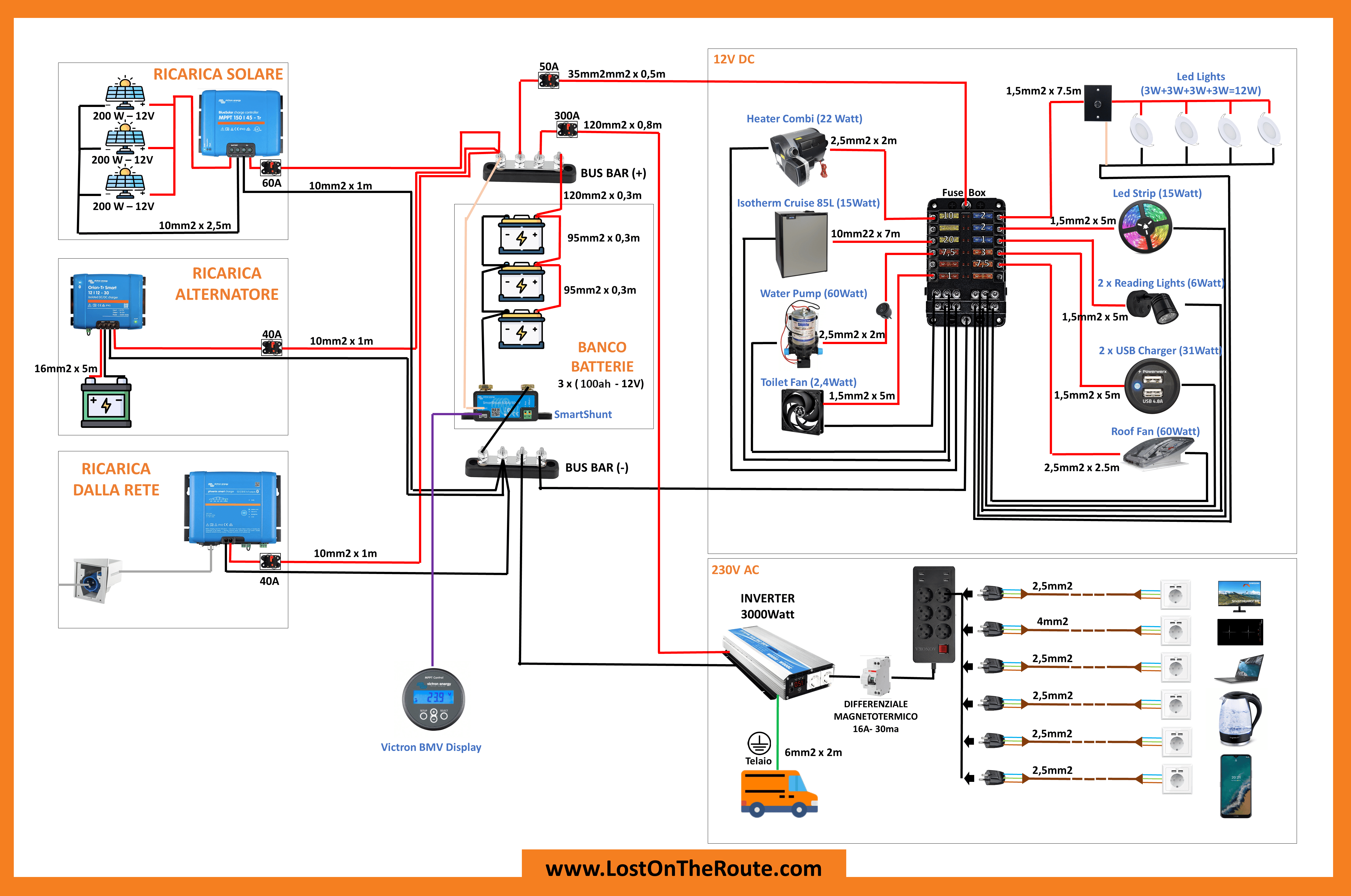
Click on the various components of the electrical system to see their details or to examine the product page directly.
FACILITY IN BRIEF
The “Advanced Lithium” electrical system is our own system, which we created and installed on our VW Crafter Arancino.
This is a system based on 300ah LifePo4 batteries and a 3000W inverter, and is designed primarily for those who want to have total independence for free parking.
The capacity of this system makes it possible to cook with an induction cooktop, while the power of the charging systems (solar and alternator) make it possible to effectively recharge the batteries both while stationary and on the move.
TECHNICAL FEATURES
- Battery Bank: 300ah LifePo4
- Usable Battery: 240ah
- Solar Charging: 600W
- Alternator Charging: Automatic, up to 30A
- Mains charging: up to 30A, full charging in one night
- Inverter Power: 3000W
- Monitoring: Monitoring via Bluetooth/ VictronConnect App + Physical Recessed Monitor
CHOOSE THIS CONFIGURATION IF:
- You have considerable energy consumption and don’t want to worry too much about having power when you need it
- Want to go the gas-free route and cook with induction or an electric stove
- You prefer free parking and plan many roadtrips
- Thinking of spending long periods in your RV and want to invest in an electrical system that makes you feel at home
APPROXIMATE COST
4000 – 4300 Euro
The cost estimate is based on Amazon prices and my personal experience and is purely indicative, to give you an idea of how much more or less, you would be going to spend.
The guideline cost includes all the essential components of the system (solar panels, chargers, batteries, inverters, fuses, cables etc.), but not the various DC and AC equipment (since everyone then plugs in what they want, and it would not make sense to put them in the count).
Since the schematic of our “Advanced Lithium” electrical system is the schematic of our electrical system, if you are interested in seeing all the costs in detail, you will find them in the article: How Much It Costs to Convert a Van DIY – Our Experience.
4. Electrical System Diagram “Lithium Ultra”
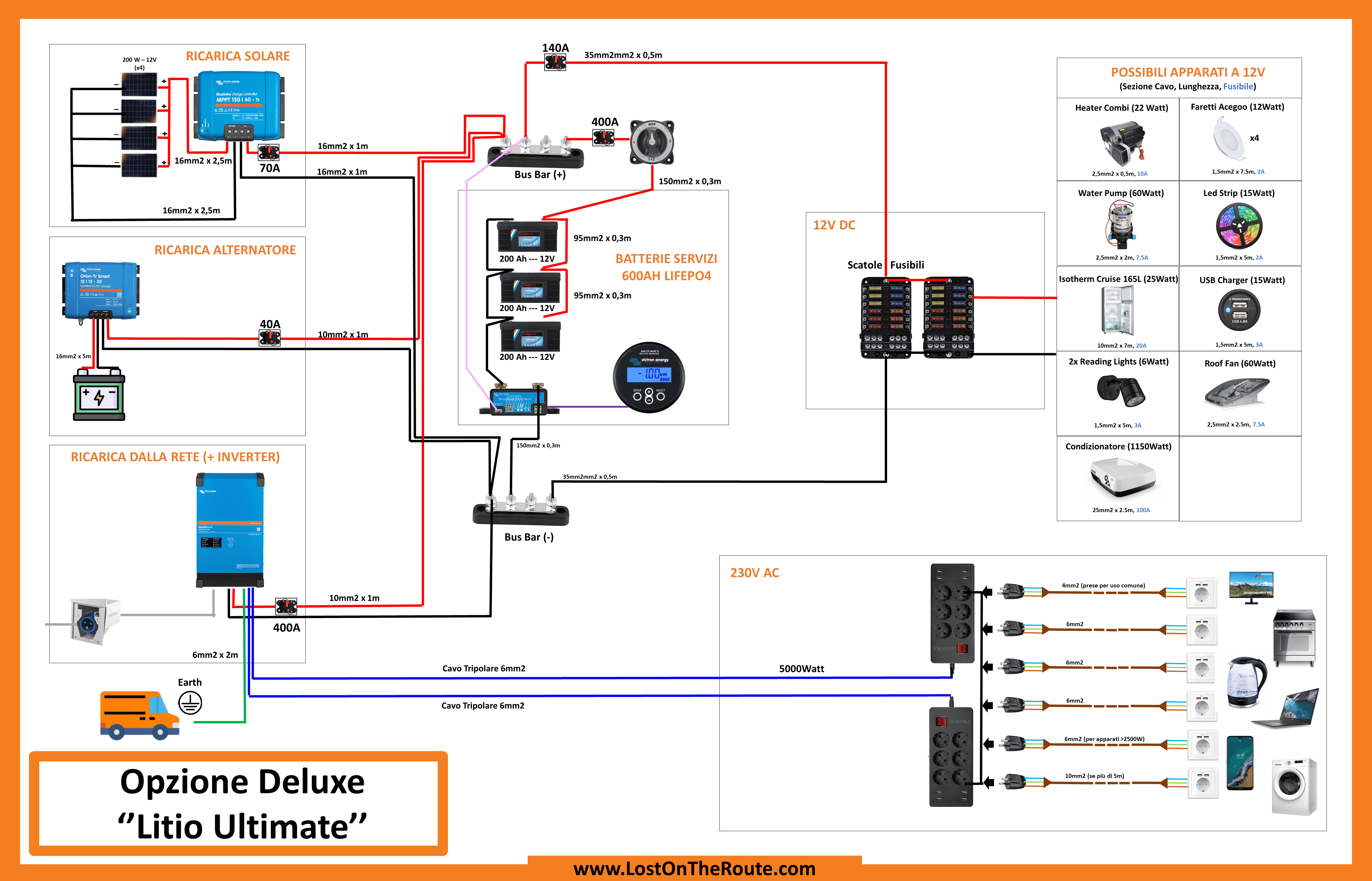
Click on the various components of the electrical system to see their details or to examine the product page directly.
FACILITY IN BRIEF
The “Lithium Ultra” electrical system is the pinnacle of a mobile vehicle electrical system.
Suitable for spacious vans, but also for trucks or otherwise larger motorhomes, it is a system designed for really special and “deluxe” projects where you really don’t want to miss anything.
With a 600ah battery bank, 800W of solar, and a 5000W inverter, an “Ultra” electrical system allows you to power even energy-hungry appliances such as a washing machine or air conditioner, and leave the worry of electricity behind. Dream.
TECHNICAL FEATURES
- Battery Bank: 600ah Lithium LifePo4
- Usable Battery: 480ah
- Solar Recharge: 800W
- Alternator Charging: Automatic, max. 30A
- Mains Charging: Up to 70A, full charging in 7 hours
- Direct Mains Power Supply: Yes
- Inverter Power: 5000W
- Monitoring: Monitoring via Bluetooth/ VictronConnect App + Physical Recessed Monitor
CHOOSE THIS CONFIGURATION IF:
- You want to build a vehicle complete with every comfort and fully autonomous
- Your vehicle is large enough to accommodate a bulkier system (especially solar panels and batteries)
- Plan to live in your vehicle full-time and make it a real apartment on wheels
- You are not content to create a simple RV, but are willing to invest the necessary to create something extraordinary
- In addition to an electric stove, do you plan to install an air conditioner, washing machine, or dishwasher
APPROXIMATE COST
7000-7500Euro
The cost estimate is based on Amazon prices and my personal experience and is purely indicative, to give you an idea of how much more or less, you would be going to spend.
The guideline cost includes all the essential components of the system (solar panels, chargers, batteries, inverters, fuses, cables etc.), but not the various DC and AC equipment (since everyone then plugs in what they want, and it would not make sense to put them in the count).
5. Stress-free Solution: the Portable Power Station
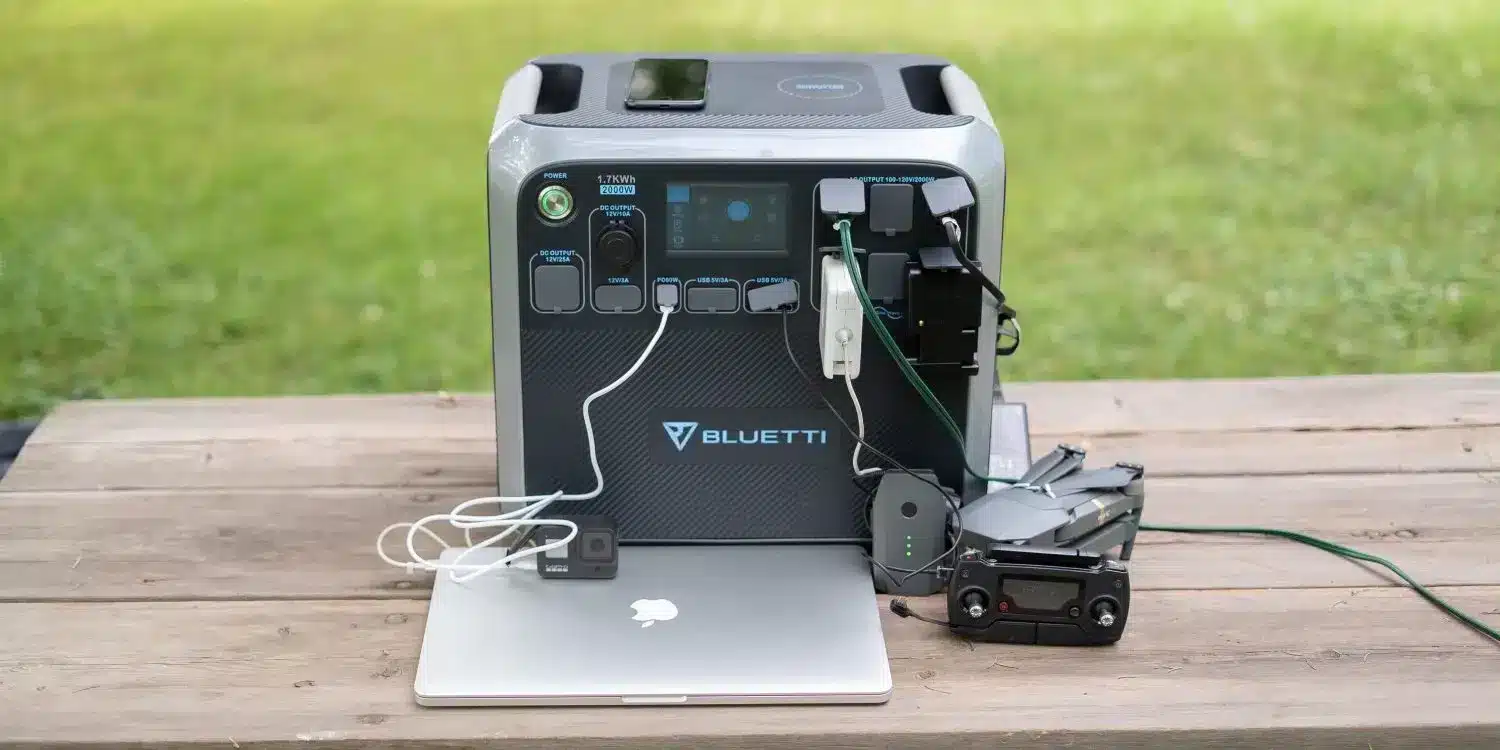
Before diving headlong into building a DIY electrical system, I personally believe it is important to ask yourself three questions:
- Are you planning/developing a fixed/permanent set-up camper?
- Economically speaking, to meet your electrical needs, does it make sense to install a complete electrical system on your camper van?
- Does the use you plan to make of your RV justify the creation of a sufficiently elaborate electrical system (such as those presented in the diagrams)?
If all your answers are YES, great: you can follow the diagram that you think is most appropriate for you and immediately start taking cues to build an electrical system tailored to your needs!
In general, for all the more ambitious van conversions, a complete RV-style electrical system makes sense both economically and as a practicality.
If, on the other hand, you found yourself responding with a few “no’s” or a few “ni’s”, this last paragraph might be for you.
In fact, many times, I recommend asking these questions to those who are engaged in more “modest” and practical conversion projects: small vans to be used on weekends or for picnics, mobile/mobile setups, or otherwise very limited electrical needs (a few chargers, a cooler, a hair dryer etc.).
If your energy needs are limited, if you are creating a mobile set-up to avoid having to homologate your Do-It-Yourself Campervan or however you don’t think it’s for you to wire a complete electrical system, in this last paragraph I would like to introduce you to one last option to have electricity available in your camper safely: the Portable Power Station.
Portable Power Stations, are essentially technological “boxes,” ready-made all-in-one powerbanks that mimic the functions of a traditional electrical systems: are generally recharged by 220V, but can also be recharged by solar, contain an inverter and 220V outlets already wired, and most importantly, require no installation.
Personally, I consider portable PowerStations to be suitable solutions for smaller RV projects (where they can also save money), for mobile set-ups, for those who need to transport the battery bank outside the RV, or suitable for those simply looking for an energy back-up solution for their vehicle (we are thinking about it for that reason, too!).
Below, I leave you with a brief analysis of the Pros and Cons of portable power stations (I will discuss this in more detail in a future specific article on the topic).
PROS AND CONS OF PORTABLE POWERSTATIONS
PRO
- All in one solution (batteries + charge controller + inverter + AC charger + outlets)
- They do not require installation, nor buy dozens of different components. A solution for those who want to do a DIY installation but don’t trust themselves to work with too many electrical components.
- Ideal for Mobile Set-ups where you do not want to create a fixed installation
- They can also be carried and used outside the RV (beach, pool, picnic, lake etc.).
- A PowerStation can be an excellent extra power source to carry as a back-up in addition to the electrical system (for even greater range)
- Smaller models (for more modest needs) have prices that make them a good alternative to low-cost systems (considering that they do not require complicated installations)
- PowerStations can be charged at home and brought in your van completely full when needed
AGAINST
- An electrical system is expandable and changeable at will over time, while the power station limits options to its outputs
- For the same power, a portable PowerStation compared with a traditional electrical system of the same power costs 20-30% more
- In the case of short circuits or malfunctions, it is easier to work on an electrical system. Sending the PowerStation to service instead means leaving the vehicle without a “soul”
- Smaller models are generally priced to rival “low-cost” systems (for the same power, less stress to fit them), while for larger ones prices fly really high
- The warranties offered are generally 2/4 years, after which in case of malfunction the replacement cost would be very high (while for a classic electrical system, it is enough to replace only the part that breaks)
- If you plan to wire them as a fixed installation, they essentially become batteries and lose their “portability“
If the topic of PowerStations interests you., you think it might be right for you, or you simply want to learn more about the products that are currently on the market and their features, I leave below links to the sites of your top companies (and only two really reliable ones at the moment) that deal with these kinds of products: Bluetti and Ecoflow.
CLICK THE LOGO TO SEE THE RESPECTIVE WEBSITES
For the time being, I will not elaborate further on the topic as this article is designed to provide you with clear and simple diagrams to wire the perfect electrical system for your needs.
I just wanted to point out to you the existence of these portable PowerStations that, depending on the case and needs, for some projects can make sense in terms of both practicality and economics, compared to a traditional system.
6. Van Electrical Diagrams: Conclusion
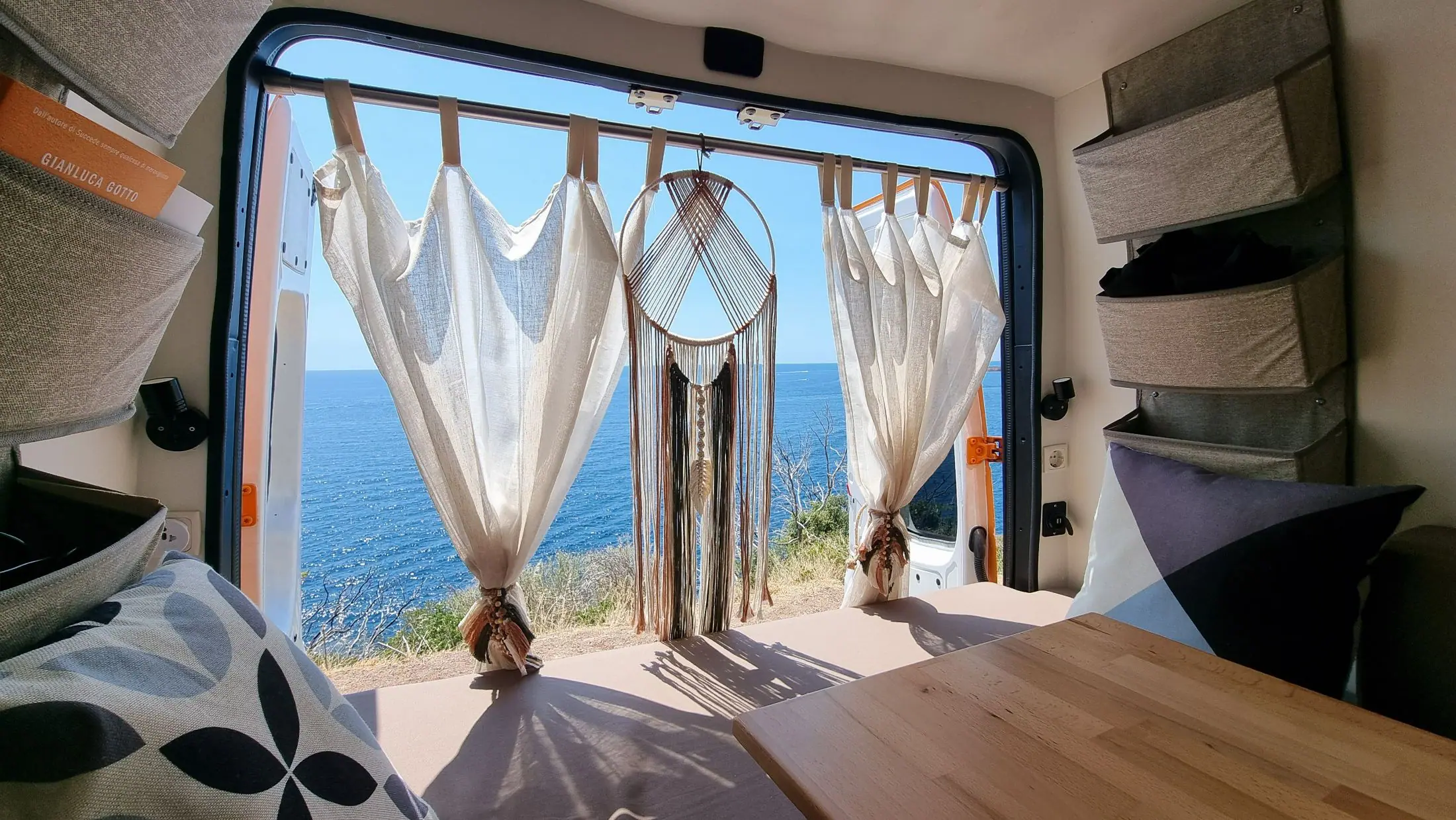
And here we come to the end of this article!
In this short guide, designed to supplement with practical and easy-to-use diagrams the Maxi-Guide on the Electrical System of a Camper Van, we have seen four different examples of diagrams for a Camper van electrical system, designed to support different needs.
Of course, each van conversion project is a world unto itself, with its own particularities and requirements, and to make something truly tailored to your project you may need to supplement or modify these diagrams according to your tastes and needs.
In any case, I hope I have given you enough insights and tools to set to work with more serenity and confidence in what you are doing. I know that creating a DIY Electrical system the first time can seem like an impossible task, but trust me that by putting your mind to it and studying a little bit, it is much more affordable than it may seem.
One last piece of advice: if in spite of everything you still have doubts, or you still do not trust yourself to get your hands on it, go to an experienced person or an electrician and ask for help. With power, it is always good to remember, no kidding, and if you are not comfortable with it, it is best to leave it to those who do it for a living.
That said, I hope this article was helpful to you.
What about you, what electrical system have you decided to create for your RV? Have you ever considered using a mobile powerstation? Do you have any tips to leave to improve the patterns or want to share a personal experience on the topic? Do you have additional concerns, questions, or comments about the article?
Let me know everything by writing me in the comments below, I’m very glad to have a dialogue on this topic that I’m very fond of 😀
Hoping the article was helpful to you, as always I thank you for reading,
And see you in the next article! ;D
BEFORE YOU GO, CAN I ASK YOU FOR SOME FEEDBACK?
Writing detailed articles like this takes a lot of time and effort..
If you liked it, can I ask you to leave me a feedback message in the comments at the bottom of the page?
For a content-creator, knowing that you are being read and that your efforts are useful to someone is the best motivation to keep writing and doing better 🙂
Let me know what you liked or what you think could be added.
If you’d like, you can also share the article to help other people find it!
Thanks for the help 🙂

Read the Van Conversion Guides
How to Calculate the Right Section of 12V Cables | EASY GUIDE
An undersized cable does not carry enough current. A cable that is too undersized can lead to a fire. An oversized cable, on the other hand, simply costs more and is a waste of money. Are you wondering what is the logicfor choosing one section of cable over...
Bluetti vs Ecoflow | Which is the Best Portable Power Station for RV/Vanlife?
The Portable Power Station is an increasingly used accessory on camper vans and RVs, but when does it really make sense to purchase and own or install one? In this article we try to shed some light on how these systems work, the best options on the market, and the...
Van Conversion DIY: How Much Does It Costs? | My Experience
How much does it cost an entirely DIY van to campervan conversion? The queen of all questions... In this article, I want to show you all the costs of my conversion from start to finish, so that you too can get an idea of what it might cost! ...
Van Interior Conversion: Best DIY Ideas for your Project!
The Interior Outfitting of a DIY converted van is both an aesthetic and structural choice. In this article, you will find useful information and inspiration ideas for customizing the Walls, the Ceiling, and the Floor of your Van! DIY CAMPERVAN SET-UP:...
Kitchen for Camper | Best DIY Ideas for your Van Conversion
Cooking in Camper is one of those things, that makes you feel at home wherever you are! Gas, Diesel or Electric Stove? What equipment and accessories you need on the Road? How much space do you need? How to assemble the kitchen in your Camper? In this article you will...
The Best Fridge for Your Campervan – Which One to Choose?
Buying a trivalent or compressor RV refrigerator? Horizontal or vertical? 12V or 110/220V? In this article you will find all the information you need to choose the best fridge for Your Van, tailored to your Needs! 🙂 THE REFRIGERATOR IN THE VAN:...
Van Conversion: How to Build a DIY Bed for your Camper Van
A Camper is not a Camper if it does not have a bed. Where to Sleep and... Dream! In this Guide you can find the inspiration you need for creating a DIY Bed in Your Campervan, And I'll show you step by step how I built a Complete Bed/Dinette on my VW Crafter....
DIY Camper Bathroom: How to Self-Build a Toilet
If you are Campering a Van you surely must have wondered: How does the Bathroom in a Motorhome work? In this Guide I show you the various types of Bathrooms on the market, I explain how they work, and I show you how you can Build yourself an entirely...
Best 12V Fan for RV | DIY Installation Guide | Van Conversion
A Roof Fan helps keep your Vehicle's humidity under control and change stale air. In this guide you will find everything you need to know about mounting a Maxxfan Deluxe fan on the roof of YOUR van. ROOF FAN: WHAT IS IT FOR? Keeping an RV's...
How to Build a Shower in a Do-It-Yourself Camper
A Shower in the RV for some people is not necessary, for others it is a real necessity to be totally independent! In this guide I'll tell you how I built the shower of my converted van entirely Do-It-Yourself! INSTALLING A SHOWER IN A...
Complete Guide and Electrical Scheme for your D-I-Y Van Conversion
You dream of transforming your Campervan DIY and have never touched an electrical cable before? Or do you want to implement some changes to your Factory RV? In this guide you will find EVERYTHING (absolutely EVERYTHING!) you need to know to create the perfect DIY...
Converting a Van: How to Connect Electric Cables Without Mistaking
Want to know how to "connect" the electric cables in practice in a converted van? Stripping, Crimping, Wire Leads, Clamps, Tubing, Cable Ties and much more... You've come to the right place to learn All That! How to wire your van's electrical...

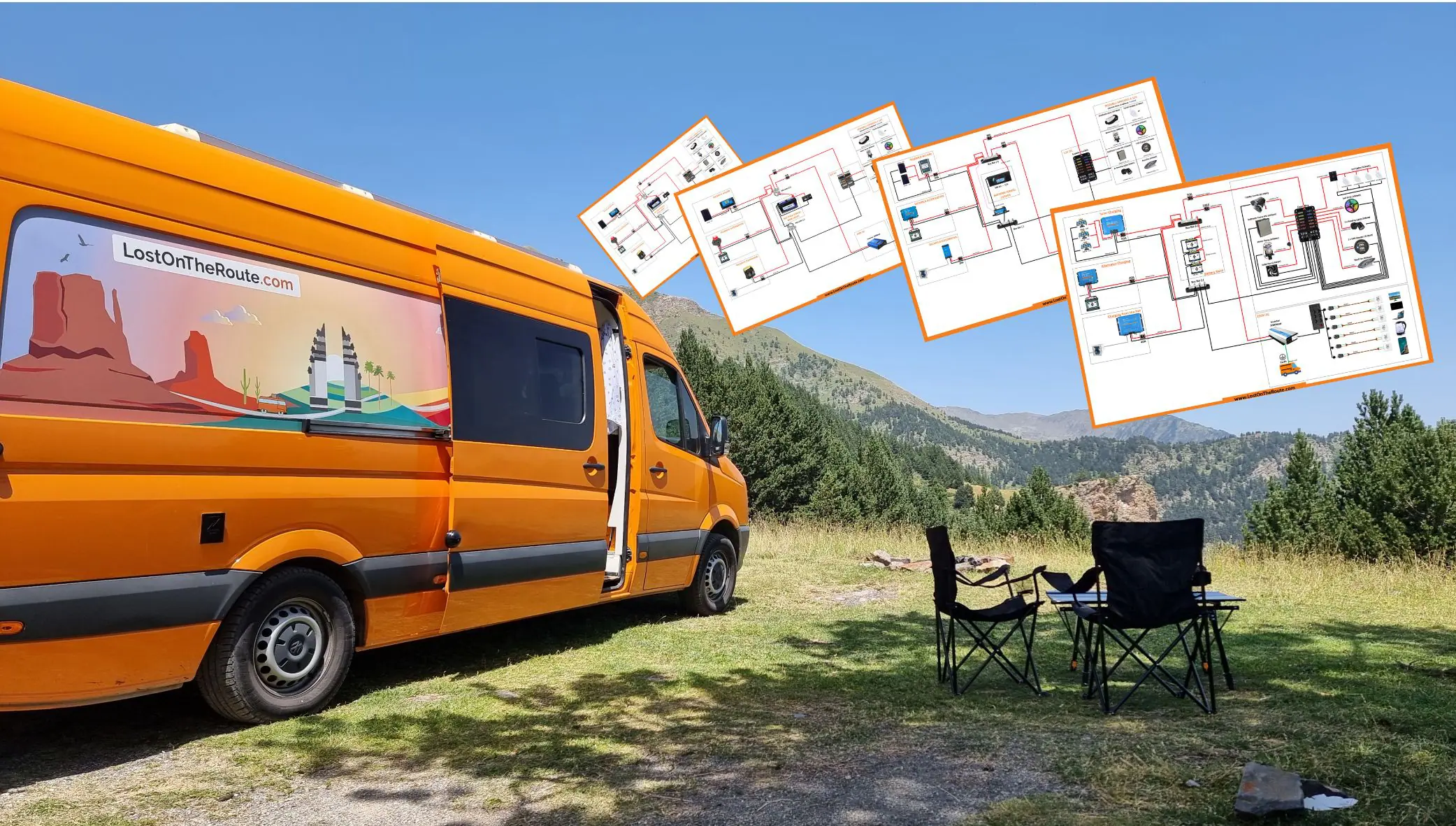



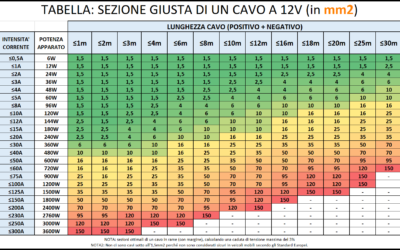
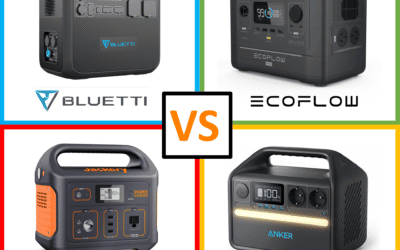



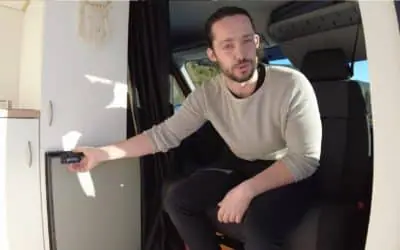
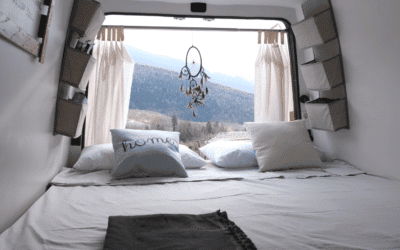

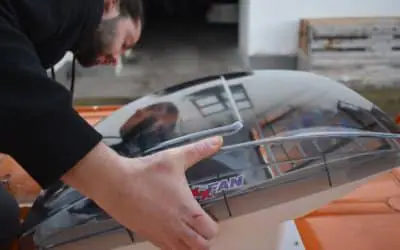
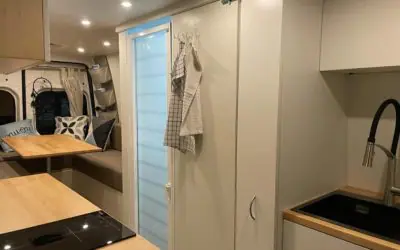
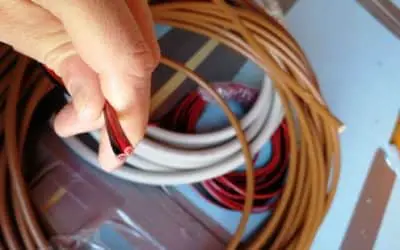
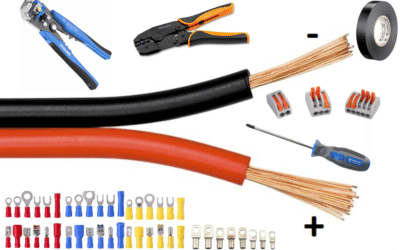



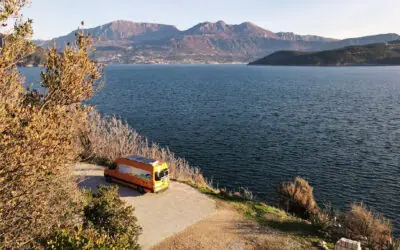
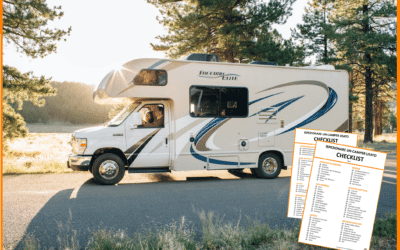



0 Comments